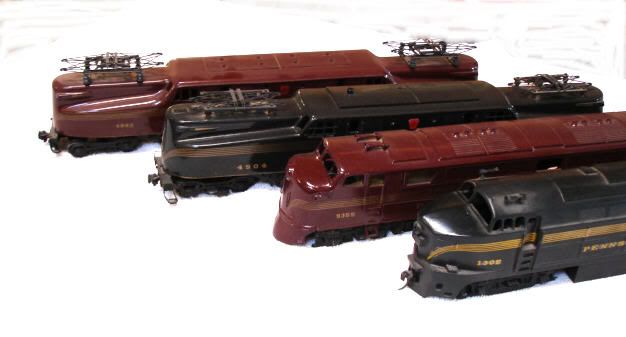Hello everyone;
A few months ago I spotted an aluminum casting of a GG1 as playing on eBay is actually more fun than television these days. I asked how long the model was as it seemed to me that it would make a great display and a starting point for educating my grandsons about electric trains - real ones. It turns out through this forum that I found out this model actually began about 1930, which is amazing as Mr. Alexander made a set of dies to produce this model. The craftsmanship was excellent. The grilles on this model are exquisite. Later Mr. Ed Duddy bought the molds and continued selling the model. There are bronze ones and aluminum ones in existence. After getting the model home There are sites on the web where original drawings of the GG1 are available and also some computer generated solid model generated photos showing the GG1 actually had two frames mounted back to back. They were joined much like a Steam engine locomotive frame and tender frame, with male and female lugs with a pin in these protrusions. The frames were like two 4-6-0 steam engines mounted back to back and there were two circular mounting points ahead of the larger drivers. Each of the six driving axles had two electric motors and ran collectively on about 11,000 volts. I am guessing the two mounts in the body must have some type of sliding device as the distance between to mounting points would lengthen straightened out and shortened while negotiating a curve. It makes me wonder why toy makers and model makers do not have the same setup on their models. When it came to mine I was wondering where to get parts to finish it.
Fortunately most of the brass additions to the model were included except two of the vents were missing. Also since one of the vents was just taped on to the model I could use it to make a template for a resin copy. I made a wood block to go behind and give masking tape some form and wound the outside leaving tape protruding beyond the outer surface. I then used some old pot plaster and carefully filled the cavity making sure no air bubbles formed. The resin quickly formed but then I had to get the plaster out so it ended up that I had to soak the plaster for several days for it to degenerate enough so I could dig it out without disturbing the resin copy. Once I had my copy, I could put masking tape on the back side of the model and again using resin carefully with a small stick line the sides of the hole and place the copy in it's final position. There were a few marks on the aluminum body so I used auto body putty to smooth these out and then I painted the model with acrylic paint that said it could be used to paint houses with aluminum siding. The Latex paint is difficult to work with and is water based so going through an air brush requires a secret formula. I am not going to be the one to let the secret out about putting some dishwasher detergent in the mixture to get it to work in an airbrush.
I had grand idea of making a wooden pattern of the frames I saw studying GG1 architecture, then use lost wax technology to form plaster molds and pour molten bronze or old lead Zamac mixtures in using an acetylene torch to melt the metal. However I cam to my senses, but not after buying a fourteen inch long GG1 I intended to steal the wheels from. I did buy the Williams GG104 model though and it has a plastic body. It too has exquisite craftsmanship although clearly it has been done with modern CNC technology. My problem now is do I have the heart to throw the plastic body away and mount the Duddy body on the Williams frame. that was the plan.
So there you have it, you start out playing with trains and then you become some kind of expert and teacher. For me modeling specific things one at a time is the fun in the hobby. Whatever you do, make sure you are having fun doing it.












